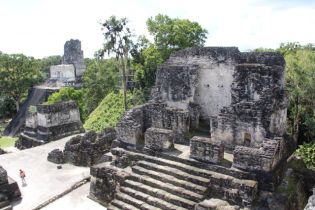Flores was a very gentle introduction to Guatemala. Late breakfasts, long lunches, great coffee and fresh mojitos all weakly balanced by very short walks sums up our time in Flores. A pretty little place, that feels like it only exists for tourists. We were here for a few days as a base to visit Tikal, one of the largest Mayan sites.
Tikal is supposedly the most magnificent of all the Maya sites. It was certainly was most impressive of the sites I have so far visited. The ruins, just outside Flores, are dominated by five enormous temples, steep-sided limestone pyramids that rise to more than 60m above the forest floor. Around them are many thousands of other structures, many semi-strangled by giant roots and still hidden beneath mounds of earth. Walking around these mounds, you wonder, just how they cannot be yet excavated or indeed how the whole place was overgrown in the first place.
The history of this site is fascinating, and I would be a fool to think I could explain it briefly or adequately so here’s links to some useful sites or alternatively below are a few extracts from the guide book to give you a sense of the place:
http://whc.unesco.org/en/list/64
http://www.tikalpark.com/generalinfo.htm
Extract from the Rough Guide to Guatemala
” The first occupants of Tikal arrived around 900 BC and it remained a minor settlement during the latter years. Tikal from 400–909 AD. became one of the most elaborate and magnificent of all Maya city-states, monopolizing the crucial lowland trade routes, its influence reaching as far as Copán in Honduras. At the height of the Classic period, Tikal’s population had grown to somewhere around 100,000 (some Mayanists argue for much more) spread across a central area covering about thirty square kilometres.
By the beginning of the ninth century, severe signs of crisis emerged across the entire Maya region – probably sparked by a period of climate change, including a catastrophic drought. Population levels at Tikal plummeted, as people fled the area. Tikal’s last recorded monument is inscribed on Stela 24, completed in 869 AD. What brought about Tikal’s final downfall remains a mystery, but what is certain is that at about 900 AD almost the entire lowland Maya civilization collapsed, and Tikal was effectively abandoned by the end of the tenth century. Afterwards, the site was used from time to time by other groups, who worshipped here and repositioned many of the stelae, but it was never occupied again.
Rediscovery : After its mysterious decline little is known of Tikal until 1695 when a lost priest, Father Avendaño, stumbled upon a “variety of old buildings”. The colonial powers were distinctly unimpressed by Petén and for the next 150 years the ruins were left to the jungle. In 1848 they were rediscovered by a government expedition led by Modesto Méndez. Later in the nineteenth century, a Swiss scientist visited the site and removed the beautifully carved wooden lintels from the tops of Temples I and IV – they are in a museum in Basel – and in 1881 the English archeologist Maudslay took the first photographs of the ruins, showing the main temples cloaked in tropical vegetation.
Until 1951 the site could only be reached on horseback – with considerable difficulty – and although there was a steady trickle of visitors the ruins remained mostly choked in jungle. The gargantuan project to excavate and restore the site started in 1956 and involved teams from the University of Pennsylvania in the US and Guatemala’s Institute of Anthropology.
Much of the major work was completed by 1984, but thousands of minor buildings remain buried by roots, shoots and rubble. There’s little doubt that an incredible amount is waiting to be found – as recently as 1996 a workman unearthed a stela (Stela 40, datingfrom 468 AD) while mowing the grass on the Great Plaza. “














